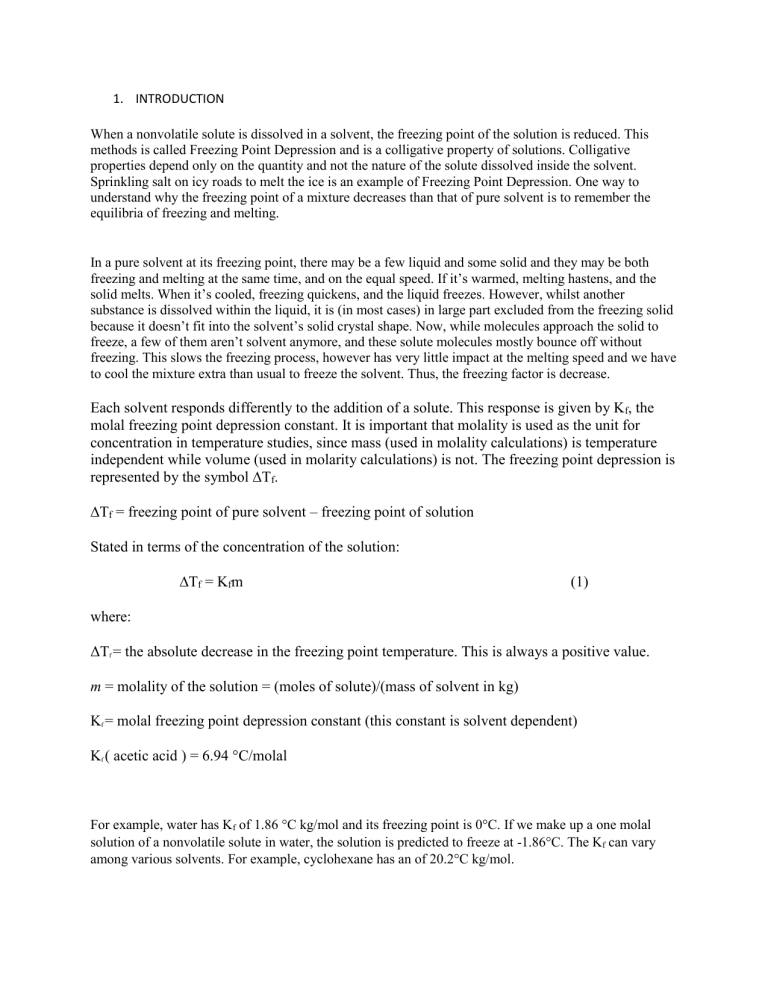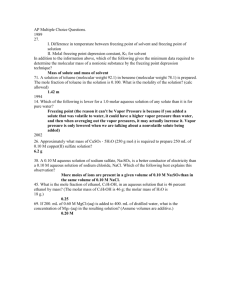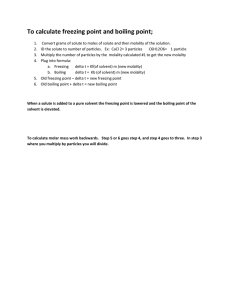
1. INTRODUCTION When a nonvolatile solute is dissolved in a solvent, the freezing point of the solution is reduced. This methods is called Freezing Point Depression and is a colligative property of solutions. Colligative properties depend only on the quantity and not the nature of the solute dissolved inside the solvent. Sprinkling salt on icy roads to melt the ice is an example of Freezing Point Depression. One way to understand why the freezing point of a mixture decreases than that of pure solvent is to remember the equilibria of freezing and melting. In a pure solvent at its freezing point, there may be a few liquid and some solid and they may be both freezing and melting at the same time, and on the equal speed. If it’s warmed, melting hastens, and the solid melts. When it’s cooled, freezing quickens, and the liquid freezes. However, whilst another substance is dissolved within the liquid, it is (in most cases) in large part excluded from the freezing solid because it doesn’t fit into the solvent’s solid crystal shape. Now, while molecules approach the solid to freeze, a few of them aren’t solvent anymore, and these solute molecules mostly bounce off without freezing. This slows the freezing process, however has very little impact at the melting speed and we have to cool the mixture extra than usual to freeze the solvent. Thus, the freezing factor is decrease. Each solvent responds differently to the addition of a solute. This response is given by Kf, the molal freezing point depression constant. It is important that molality is used as the unit for concentration in temperature studies, since mass (used in molality calculations) is temperature independent while volume (used in molarity calculations) is not. The freezing point depression is represented by the symbol ∆Tf. ∆Tf = freezing point of pure solvent – freezing point of solution Stated in terms of the concentration of the solution: ∆Tf = Kfm (1) where: ΔTf = the absolute decrease in the freezing point temperature. This is always a positive value. m = molality of the solution = (moles of solute)/(mass of solvent in kg) Kf = molal freezing point depression constant (this constant is solvent dependent) Kf ( acetic acid ) = 6.94 °C/molal For example, water has Kf of 1.86 °C kg/mol and its freezing point is 0°C. If we make up a one molal solution of a nonvolatile solute in water, the solution is predicted to freeze at -1.86°C. The Kf can vary among various solvents. For example, cyclohexane has an of 20.2°C kg/mol. Substituting the units of molality into equation (1) we get: ∆Tf = Kf[ Since mol = grams/molar mass, we can substitute into equation (2) to get: ∆Tf = Rearranging to solve for molar mass we get: (𝐾𝑓)(𝑔𝑠𝑜𝑙𝑢𝑡𝑒) MMsolute = (∆𝑇𝑓)(𝑘𝑔𝑠𝑜𝑙𝑣𝑒𝑛𝑡) 2. OBJECTIVES (2)




